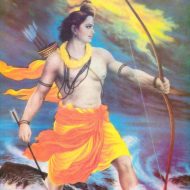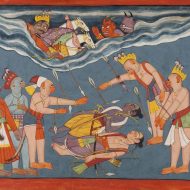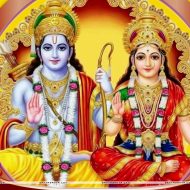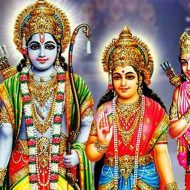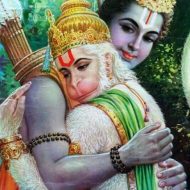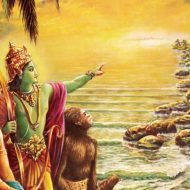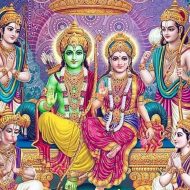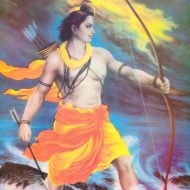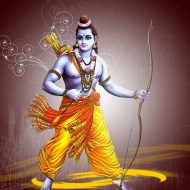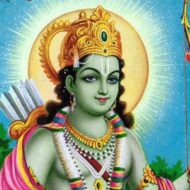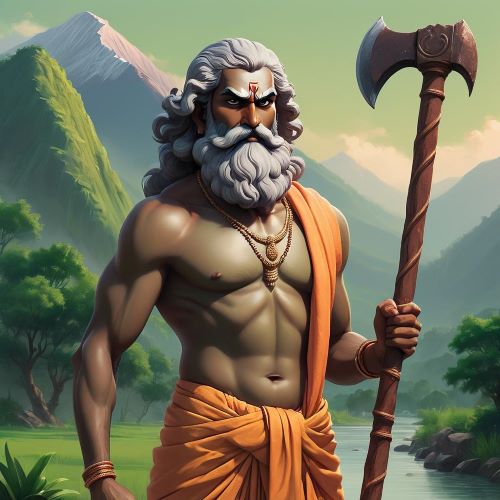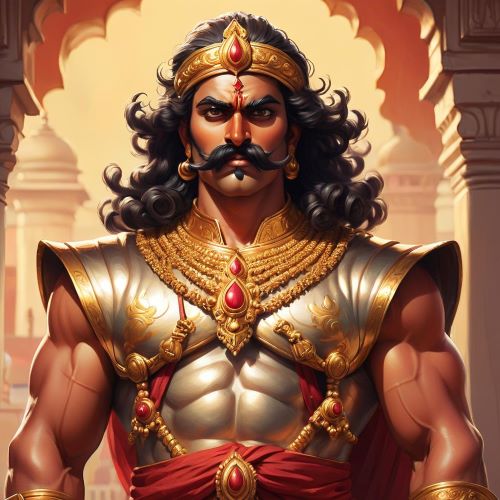Rama : The Model King
At a glance
| Description | |
|---|---|
| Origin | Indian Mythology |
| Classification | Demigods |
| Family Members | Dashrath (Father), Kausalya (Mother), Sita (Wife), Lakshmana (Brother), Bharatha (Brother), Shatrugnha (Brother), Luv (Son), Kush (Son) |
| Region | India |
| Associated With | Royalty, Virtue, Ethics, War |
Lord Rama: Seventh Avatar of Vishnu
Introduction
Rama is the seventh avatar of the Hindu god Vishnu. He has various adventures and legends attributed to him, including the slaying of Ravana. Lord Rama, who is considered to be the most pious figure in Hindu mythology, is depicted as a man of purity and devotion. He and his wife, Sita, are also depicted as pious individuals.
Rama is worshipped in various parts of India and Southeast Asia. He is most notable in Uttar Pradesh and Bihar in India. He is also considered an avatar of Buddha by some Buddhists. In art, Rama is usually portrayed with his family, including Laksmana, Hanuman, and Sita.
Physical Traits
In art, Rama is always young and has green or blue skin, and he usually wears a yellow robe. He often has a bow and arrows in his hands. He has broad shoulders, a charming countenance, and piercing and coppery eyes. He was known to have a deep voice and a dark brown complexion.
Family
Rama is the son of King Dasaratha and Queen Kausalya. He came into the world at the behest of the gods to Lord Vishnu to deal with Ravana, who was a demon king. The pious king was presented with a pot of nectar during a sacrificial fire and gave half of it to Kausalya who produced half-divine Rama as a consequence. Rama had three half-brothers – Bharata, Lakshmana, and Shatrughna – all with some, albeit lesser, divine qualities. He had 2 step mothers by the names of Sumitra and Kaikeyi. Rama’s favourite brother and great companion was Laksmana, son of Sumitra, while his loyal servant was the monkey warrior Hanuman (or Hanumat).
Other Names
Rama is known by many names today with many of them escribing his various qualities. The most common or popular ones include Ram, Ramachandra, Ramlalla, Rajeevalochana, Janakivallabha, Janardhana, Satyavrata, Trivikrama and Raghava.
Powers and Abilities
Rama was the epitome of virtue and was believed to always stand on the side of morality. As a warrior he was unsurpassed in his time with complete mastery over the bow and arrow. He was also a master strategist and diplomat.
Modern Day Influence
Rama has elements of both Hindu and non-Vishnu avatars. He has a bana in his right hand and a dhanus in his left. He is usually shown in a tribhanga pose. If his wife or brother is also involved in the iconography, then the icon of Lakshmana would be placed on his left and Sita on the right. Hanuman is usually shown as kneeling before them.
Ramnavami, Diwali, Dusserah etc are major festivals in India which are dedicated to Ram and his many achievements. These festivals are celebrated even today with much fanfare and devotion.
Related Images
Frequently Asked Questions
What is Rama the god of?
Rama is not technically a god in the traditional sense, but rather an avatar of Vishnu, who is one of the most important gods in Hinduism. Vishnu is often considered the supreme god, responsible for preserving and protecting the universe. As an avatar, Rama represents a specific incarnation of Vishnu on Earth. He is considered the seventh avatar and is revered for his righteousness, piety, and devotion to duty.
How many died in Ramayana war?
The exact number of casualties in the Ramayana war remains unknown. Varying estimates exist, ranging from 100,000 to 1.6 million, depending on interpretations of descriptions within the text and the size of the armies involved. While the precise figure remains elusive, the Ramayana war undoubtedly caused significant loss of life, making it a major and impactful event in Hindu mythology.
How is Rama born?
Rama’s birth is a divine event signifying the descent of a god onto Earth. While exact details vary, the core narrative involves a religious ritual, auspicious timing, miraculous occurrences, and multiple mothers playing a role. Ultimately, his birth symbolizes the triumph of good over evil and the restoration of order and righteousness.
How did Sri Rama died?
Sri Rama’s departure from the earthly realm is not a traditional death but an ascension to his divine source. He enters a deep meditative state (Yoga Nidra) or performs a water ritual (Jal Samadhi), symbolizing his merging with the divine and leaving his physical form behind. This signifies the impermanence of the earthly world and the eternal nature of the divine. Interpretations may vary, but the core message remains consistent: Sri Rama’s journey and ascension represent the triumph of good and his ultimate return to the divine.
How long did Rama live?
Determining Rama’s lifespan is complex, as the Ramayana offers different perspectives. Some interpret it literally, suggesting a 11,000-year life based on the text’s descriptions. Others view it symbolically, suggesting a lifespan closer to that of an average human. Ultimately, the exact duration remains open to interpretation and individual understanding.



